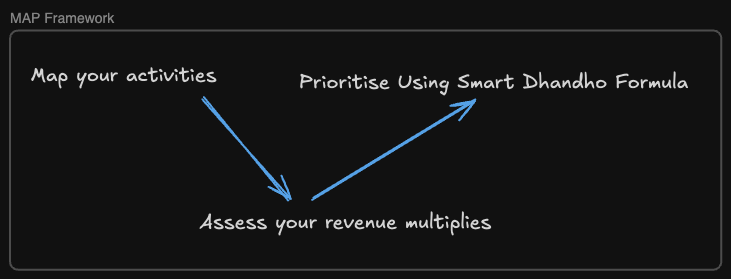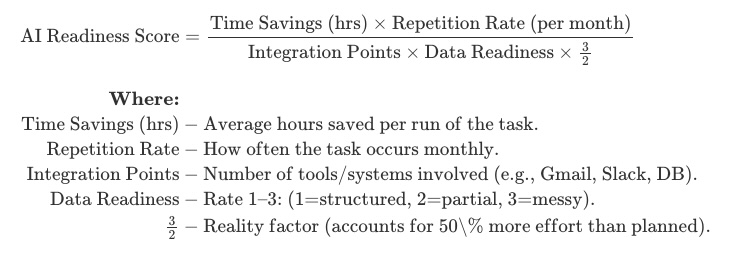Why Smart Business Owners Don't Automate Their Most Frustrating Task First?
The equation smart business owners use to identify their highest-ROI automation opportunity with AI

Photo by Google DeepMind
You know you should be doing something with AI, but where do you even start?
Every week brings a new “breakthrough” tool, another case study, or a viral post claiming to have cracked the AI code.
Your competitors are showing off their “AI-powered” workflows.
Your inbox is full of newsletters promising instant automation wins.
But when you sit down to apply it to your own business, the excitement quickly turns into confusion.
There are too many tools.
Too many options.
And not enough time to figure out what actually matters.
So you decide to wait it out, not because you’re ignoring AI, but because you don’t want to waste effort chasing shiny objects.
You’re trying to be strategic. But the longer you wait, the louder the noise gets, and the more it feels like everyone else is racing ahead.
Here’s what no one’s telling you:
Most businesses are automating the wrong things first.
They’re buying every new AI tool like someone stocking up on kitchen gadgets, only to realise they still don’t know what to cook.
The tools aren’t the problem. The strategy is.
The Hidden Cost of Waiting
Before we dive into solutions, let’s be honest about what’s really happening here.
Every week you delay implementing AI, you’re not just losing time. You’re losing compound advantage. While you spend 10 hours on tasks that could be automated, your competitors are spending those same 10 hours on strategy, customer relationships, or product development.
It gets worse. Your team sees you struggling with repetitive work. They know there are better ways. Some of your best people might be thinking,
“If this company can’t even automate basic tasks, what’s my future here?”
And your customers? They’re getting instant responses from your competitors’ AI chatbots while waiting two days for your manual email reply.
This isn’t about keeping up with technology trends. It’s about survival.
Why Most AI Implementations Fail?
You’ve probably tried already. Signed up for a tool, downloaded the Chrome extension, and watched the tutorials.
Then reality hit.
The tool didn’t fit your systems. Or it required a full workflow overhaul. Or it automated something that wasn’t actually worth automating.
You felt overwhelmed, frustrated, perhaps even further behind.
That’s because most people approach AI backwards.
They start with the tool, not the problem.
They automate what seems cool and not what actually matters.
Introducing the M.A.P. Framework
After all that noise, what you need isn’t another tool. What you need is a roadmap.
A way to see where to start, what to skip, and how to scale. That’s where the M.A.P. Framework comes in.
M - Map Your Autopilot Activities
A - Assess Revenue Multipliers
P - Prioritise Using the Smart Dhandho Formula

Step 1: Map Your Autopilot Activities
Start with this question: Which tasks do I do on complete autopilot, but still eat up hours?
Think of things like:
→ Answering the same customer questions
→ Creating similar proposals
→ Scheduling and rescheduling meetings
→ Updating predictable spreadsheets
→ Posting recurring social content
→ Processing invoices or receipts
→ Sending routine reminders
These tasks don’t need creativity. They follow repeatable patterns and can be the perfect place to start automating.
Remember to map tasks that already have a transparent, repeatable process.
Don’t automate chaos.
Step 2: Assess Your Revenue Multipliers
Flip your thinking for step 2.
What tasks directly generate revenue, but you never have enough time for?
For most businesses, it’s things like:
→ Writing personalised follow-ups
→ Creating targeted content
→ Analysing customer data for upsells
→ Building new service packages
→ Nurturing high-value clients
→ Crafting campaigns that convert
→ Researching new partnerships
These are your revenue multipliers, where an extra hour of focus can yield exponential returns.
AI isn’t just about saving time here. It is about scaling your existing business.
Step 3: Prioritise with the AI Dhandho Readiness Equation
Now you may have 3–10+ ideas to use. This is where you can go to the stuck state, as all the ideas seem good, but you’re not sure which one to follow.
That’s why I built the Smart Dhandho Formula, the final step in the M.A.P. framework.
The Smart Dhandho Formula gives you an AI Readiness score.

You want the AI readiness score to be higher. The higher the score, the better the candidate is for automated AI.
Examples
Option A: Email Newsletter Creation
You have a weekly newsletter. The flow you might be using is that you write the post, get the images from unsplash.com and publish to Substack. So the number of systems you integrate is 2. Here, there are no data sources, as the assumption is that you are creating from scratch. It takes about 4 hours to write 1 newsletter for you.
Time saved = 4 hours
Repetition Rate = 4 times per month
Integration Point = 2
Data Readiness = 1 (your data is ready and available)
AI Readiness Score = (4×4) ÷ (2×1×1.5) = 16 ÷ 3 = 5.33 🟢
Now, if you also look up certain websites for input for your newsletter, those websites become 1 more integration point. The number of integration points is 3 if we consider only 1 website to be looked up. As this is an external website, the data might not be in the exact format that you want. It means the data readiness is 2 (partial).
Time saved = 4 hours
Repetition Rate = 4 times per month
Integration Point = 3
Data Readiness = 2 (the data from the website is messy)
AI Readiness Score = (4×4) ÷ (3×2×1.5) = 16 ÷ 9 = 1.77 🔴
Option B: Customer FAQ Responses
Let’s take another scenario. You have a service for which customer emails you with their queries. Most of the time, you answer the question and provide a link to your knowledge base so customers don’t have to email you.
Assume it takes about 30 minutes every day to resolve these queries. Now there is only 1 system which is your knowledge base. The data is structured in your knowledge base.
Time saved = 0.5
Repetition Rate = 20 times per month
Integration Point = 1
Data Readiness = 1 (your data is ready and available)
AI Readiness Score = (0.5×20) ÷ (1×1×1.5) = 10 ÷ 1.5 = 6.67 🟢
Even though the newsletter feels like a bigger time sink, automating the FAQ might just edge you in terms of return on investment.
The Magic Threshold

Above 5: Automate now.
2–5: Automate next wave.
Below 2: Keep manual for now.
This equation saves you from the two biggest traps:
The Complexity Trap: Massive potential, but tangled systems. Wait until later.
The Trivial Automation: Tiny wins that waste setup time. Skip it.
The M.A.P. Framework in Action
When you follow M.A.P., you:
→ Map actual time, not guesses
→ Assess automation by impact, not hype
→ Prioritize using data, not gut feelings
That’s the essence of AI Dhandho, using leverage intelligently, not impulsively.
The Real Win
When you use the M.A.P. Framework, you stop reacting to AI trends and start making deliberate moves.
You’ll know exactly which parts of your business to automate first, and which ones can wait.
You’ll regain time, focus, and momentum not by chasing tools, but by applying leverage where it matters most.
That’s what AI Dhandho is all about: doing smart business, not busy business.
Next Steps
The M.A.P. framework isn’t just theory. It’s a practical system you can implement starting today.
Begin small. Pick one process this week and calculate its AI Readiness Score. You might be surprised by what the numbers reveal.
If you find yourself with questions or want validation on your calculations, I’m here to help. I’ve opened up time for AI Systems Strategy Calls where we can work through your specific situation together.
→ Book your AI Systems Strategy Call here
In this session, we’ll:
✅ Map your business processes in real-time
✅ Calculate your AI Readiness Score
✅ Identify your best first automation opportunity
No pressure, no obligation. Just two people working through the numbers to find your clearest path forward.
Because in the end, AI success isn’t about having all the tools.
It’s about knowing exactly which one to pick up first.